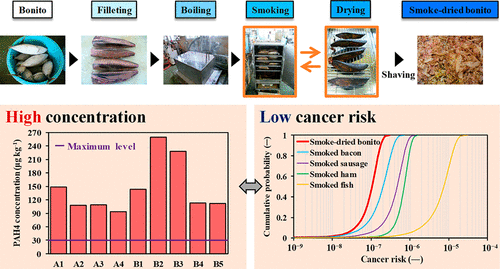当前位置:
X-MOL 学术
›
ACS Food Sci. Technol.
›
论文详情
Our official English website, www.x-mol.net, welcomes your
feedback! (Note: you will need to create a separate account there.)
Polycyclic Aromatic Hydrocarbons and Their Halogenated Derivatives in a Traditional Smoke-Dried Fish Product in Japan: Occurrence and Countermeasures
ACS Food Science & Technology ( IF 2.6 ) Pub Date : 2021-06-01 , DOI: 10.1021/acsfoodscitech.1c00085 Kento Sei 1 , Qi Wang 1 , Masahiro Tokumura 1 , Shinji Suzuki 2 , Yuichi Miyake 1 , Takashi Amagai 1
ACS Food Science & Technology ( IF 2.6 ) Pub Date : 2021-06-01 , DOI: 10.1021/acsfoodscitech.1c00085 Kento Sei 1 , Qi Wang 1 , Masahiro Tokumura 1 , Shinji Suzuki 2 , Yuichi Miyake 1 , Takashi Amagai 1
Affiliation

|
Smoke-dried bonito is a traditional Japanese processed fish product containing considerable amounts of polycyclic aromatic hydrocarbons (PAHs). Their concentrations generally exceed the maximum levels under EU regulations. Although halogenated PAHs (XPAHs) have attracted attention owing to their high toxicities, no information on the occurrence of XPAHs in smoke-dried bonito is available. In this study, we investigated the occurrence of PAHs and XPAHs in smoke-dried bonito purchased in the Japanese market in 2020 and evaluated the contamination levels in terms of concentrations and incremental lifetime cancer risks (ILCRs). The total concentrations of PAHs were 419–1070 μg kg–1 and those of XPAHs were 0.306–1.01 μg kg–1. Because smoke-dried bonito is consumed in low amounts, the ILCR of PAH4 via dietary consumption of smoke-dried bonito was the lowest among those of other smoked foods. Smoking by hot-plate heating of wood chips should be one of the effective countermeasures to reduce PAH contamination.
中文翻译:

日本传统熏干鱼制品中多环芳烃及其卤代衍生物的发生及对策
烟熏鲣鱼是一种传统的日本加工鱼产品,含有大量多环芳烃 (PAH)。它们的浓度通常超过欧盟法规规定的最高水平。尽管卤化多环芳烃 (XPAHs) 因其高毒性而备受关注,但目前尚无关于烟干鲣鱼中存在 XPAHs 的信息。在本研究中,我们调查了 2020 年在日本市场购买的烟熏鲣鱼中 PAH 和 XPAH 的发生情况,并根据浓度和增加的终生癌症风险 (ILCR) 评估了污染水平。PAHs 的总浓度为 419–1070 µg kg –1,XPAHs 的总浓度为 0.306–1.01 µg kg –1. 由于烟干鲣鱼的摄入量较低,因此通过膳食摄入烟干鲣鱼的 PAH4 ILCR 在其他烟熏食品中最低。通过热板加热木片来吸烟应该是减少多环芳烃污染的有效对策之一。
更新日期:2021-06-18
中文翻译:

日本传统熏干鱼制品中多环芳烃及其卤代衍生物的发生及对策
烟熏鲣鱼是一种传统的日本加工鱼产品,含有大量多环芳烃 (PAH)。它们的浓度通常超过欧盟法规规定的最高水平。尽管卤化多环芳烃 (XPAHs) 因其高毒性而备受关注,但目前尚无关于烟干鲣鱼中存在 XPAHs 的信息。在本研究中,我们调查了 2020 年在日本市场购买的烟熏鲣鱼中 PAH 和 XPAH 的发生情况,并根据浓度和增加的终生癌症风险 (ILCR) 评估了污染水平。PAHs 的总浓度为 419–1070 µg kg –1,XPAHs 的总浓度为 0.306–1.01 µg kg –1. 由于烟干鲣鱼的摄入量较低,因此通过膳食摄入烟干鲣鱼的 PAH4 ILCR 在其他烟熏食品中最低。通过热板加热木片来吸烟应该是减少多环芳烃污染的有效对策之一。











































 京公网安备 11010802027423号
京公网安备 11010802027423号